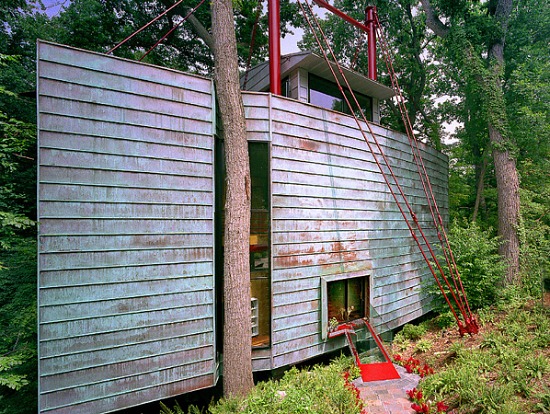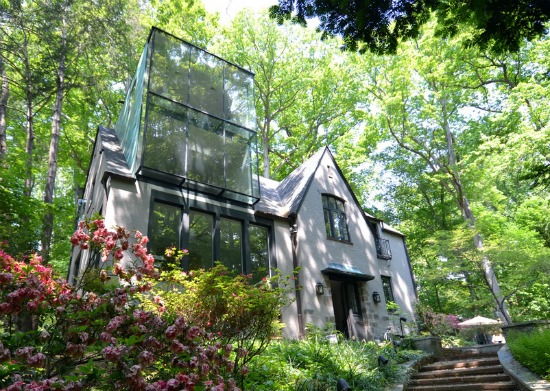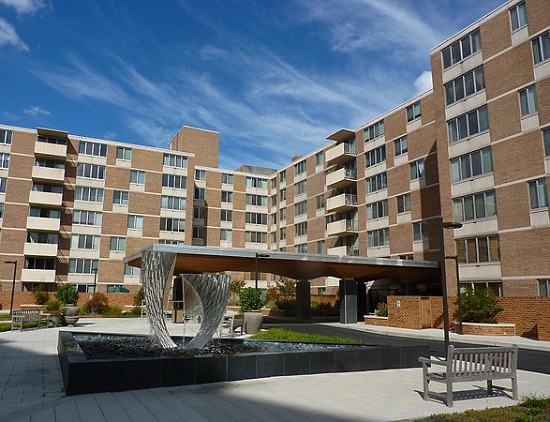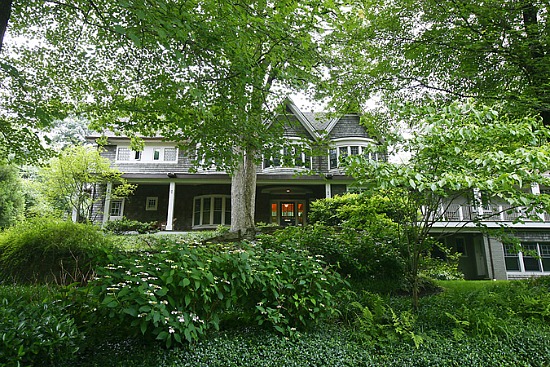 Forest Hills: Ambassadors and Adventurous Architecture
Forest Hills: Ambassadors and Adventurous Architecture
✉️ Want to forward this article? Click here.

A home on Chesterfield Place in Forest Hills
When UrbanTurf features a Forest Hills home, it usually elicits "That doesn't look like DC!" comments. For people used to looking at Victorians and row houses, the walls of glass, metal facades and giant stucco mansions feel very novel. While there are many traditional homes here, the residential neighborhood in upper northwest DC is a distilled picture of another side of the city: modern, international and ambitious.
An Appropriately Named Neighborhood
Forest Hills is bounded by Connecticut Avenue to the West, Rock Creek Park to the east, roughly Van Ness Street to the south and Broad Branch Road and 36th Street to the north. The woodsy surroundings shield residents from the hustle and bustle, but they are not too far from Van Ness and retail/restaurant options like Politics and Prose and Bucks Fishing & Camping at the corner of Connecticut and Nebraska Avenue NW.
The semi-suburban neighborhood is notable for its eclectic, pricey residential real estate: modern gems tucked into forested hills (this neighborhood's moniker is very apt), stately colonials on quiet, winding streets, and gated ambassadorial residences on large swaths of land. The location to the west of Rock Creek Park also means steep angles, creating some dramatic cliff-dwelling homes and a pushing-the-boundaries vibe is detectable in the contemporary architecture.

A modern addition on a traditional home. Courtesy of Travis Price.
A Delightful Place for Architecture Fans
Drive around Forest Hills and you'll take in an architectural smorgasbord. While many of the homes are hidden by foliage, you can spy charming Tudors, historic colonials and the occasional stuccoed, Spanish-style mansion amidst rectangular contemporaries. The neighborhood's priciest homes, which rarely sell for below $2 million, are often owned by diplomats, lobbyists and some of DC's most powerful residents. Former presidents and Washington aristocracy like Marjorie Merriweather Post and FBI Director J. Edgar Hoover have lived in Forest Hills. Travis Price has been credited with shifting the architectural landscape in the neighborhood. In 2002, he built a cantilevered, three-bedroom home overlooking Rock Creek Park. One side consists completely of windows and the other is a curved, greening copper that suggests the hull of a ship. The aggressive shock of metal was contagious; Price has now built three homes in Forest Hills and added a modern addition to one neighbor's traditional home. "She loved the idea of exploding out of the roof into nature," remembers Price.

A Travis Price home under construction.

Rendering of the finished product. Courtesy of Travis Price.
The many ambassador residences throughout the neighborhood contribute to an international feel, and the area seems to attract homeowners who are drawn to more adventurous architecture. "We jokingly call it Ambassador Hill," Price said. Along with a few fellow modern architects, Price has been discussing the possibility of filling the neighborhood with modern edifices. While Forest Hills is known for its oversized homes, the southern part of the neighborhood also has some reasonably priced condos and co-ops. One-bedroom units can sell in the $300's, with two-bedrooms reaching into the $400's and $500's.

Van Ness East
Ten years ago, Kitty Eisele, a senior editor with NPR's Morning Edition, bought a 900 square-foot one-bedroom unit in Van Ness East at 2939 Van Ness Street NW. Van Ness East is part of a larger complex that includes Van Ness North, a co-op building, and the Archstone Van Ness apartments. "When I bought here, there was a DC bonds program that encouraged middle-income people to stay in the neighborhood," Eisele told UrbanTurf. The building, which was built in the 1960's, faces into Soapstone Valley Park. "There are deer, foxes and raccoons. It’s like coming home to a moonlight sonata," Eisele told UrbanTurf. "Washington is so high energy that there is something very nice about coming back to a very serene, very well-cared-for property." Eisele liked the building so much that she bought the unit adjacent to hers, which she currently rents out.
Some Quiet Non-Residential Neighbors
Within the boundaries of Forest Hills, you won't find any restaurants or stores, but as noted above, there are commercial options nearby. Van Ness offers small eateries, a Starbucks, a dry cleaners and Calvert Woodley, one of DC's better wine shops. To the north is the small Connecticut Avenue commercial stretch that includes the bookstore Politics and Prose, a CVS Pharmacy, Marvelous Market, restaurants like Buck's Fishing and Camping and Jake's American Grille, and Comet Ping Pong, a pizza and ping pong outpost that has livened up the block. The Hillwood Museum and Gardens at 4155 Linnean Avenue falls within the bounds of the neighborhood and offers interested folks a chance to explore the grounds of a tony DC estate. Geophysicists and astrophysicists can be found in labs at the Carnegie Institute's Department of Terrestrial Magnetism (the name refers to their original task of mapping the earth's magnetic field, completed almost a century ago) at 5241 Broad Branch Road. In addition to Rock Creek Park, there are a few playgrounds throughout the neighborhood, like Forest Hills playground on Brandywine Street and Linnean playground at Linnean Avenue and Fessenden Street. Forest Hills residents are zoned for some of DC's highest rated public schools, like Murch Elementary, Deal Middle School and Woodrow Wilson High School. There are also several private schools nearby.
The Bottom Line
Forest Hills is a swanky suburban-feeling neighborhood that offers a variety of housing options ranging from reasonably priced condos and co-ops to some of DC's higher-priced real estate. While the neighborhood is largely developed, a few more striking modern homes may cement its reputation as a destination for architectural risk takers.
- Zip Code: 20008
- Forest Hills real estate data from Redfin
See other articles related to: forest hills, hoods, neighborhood profile
This article originally published at http://dc.urbanturf.production.logicbrush.com/articles/blog/forest_hills_ambassadors_and_adventurous_architecture/5260.
Most Popular... This Week • Last 30 Days • Ever

With frigid weather hitting the region, these tips are important for homeowners to ke... read »

Today, UrbanTurf offers a brief explanation of what it means to lock in an interest r... read »

A new report from DC’s Office of Revenue Analysis highlights how millennials and wo... read »

The 30,000 square-foot home along the Potomac River sold at auction on Thursday night... read »

An application extending approval of Friendship Center, a 310-unit development along ... read »
DC Real Estate Guides
Short guides to navigating the DC-area real estate market
We've collected all our helpful guides for buying, selling and renting in and around Washington, DC in one place. Start browsing below!
First-Timer Primers
Intro guides for first-time home buyers
Unique Spaces
Awesome and unusual real estate from across the DC Metro















